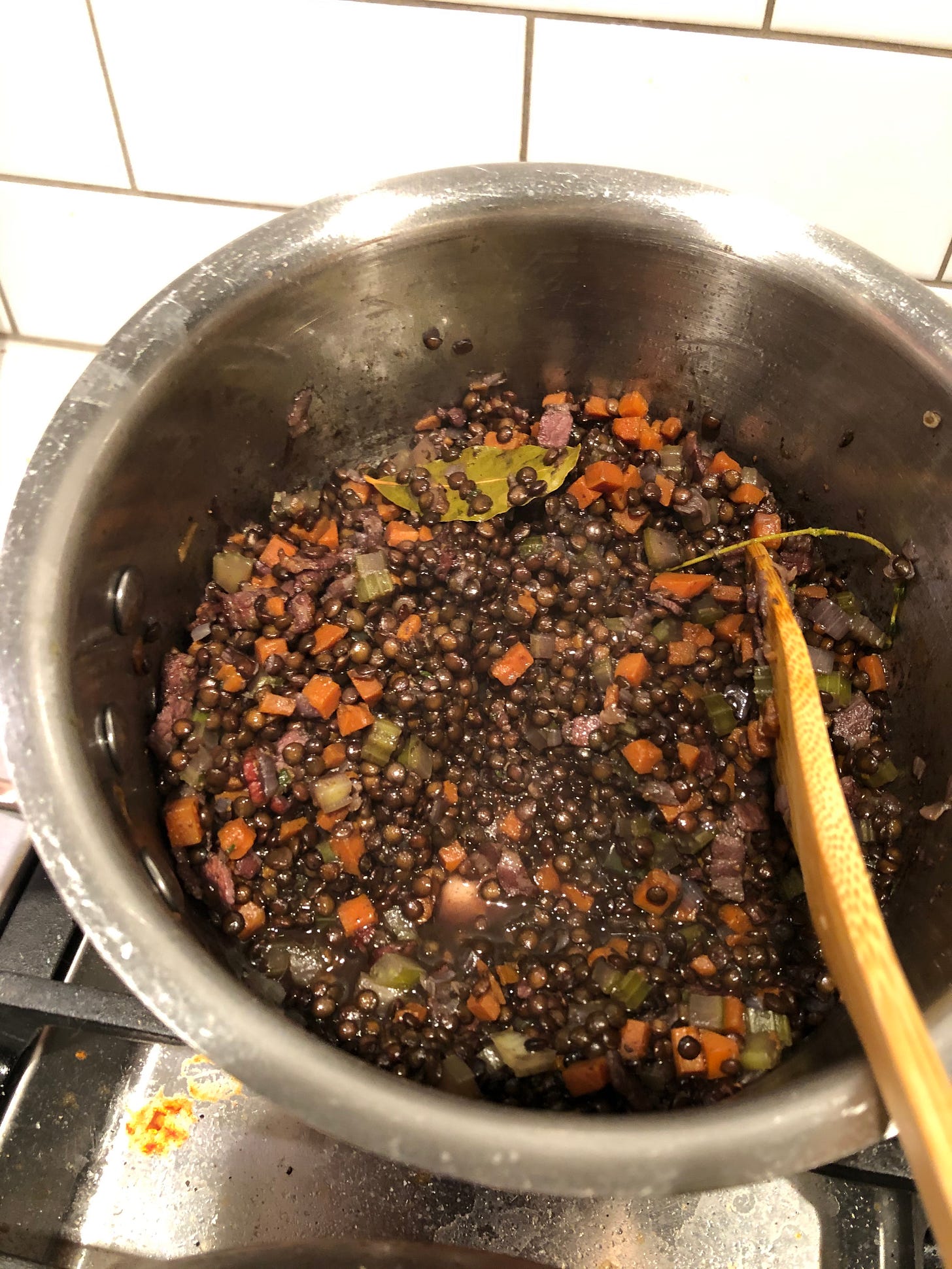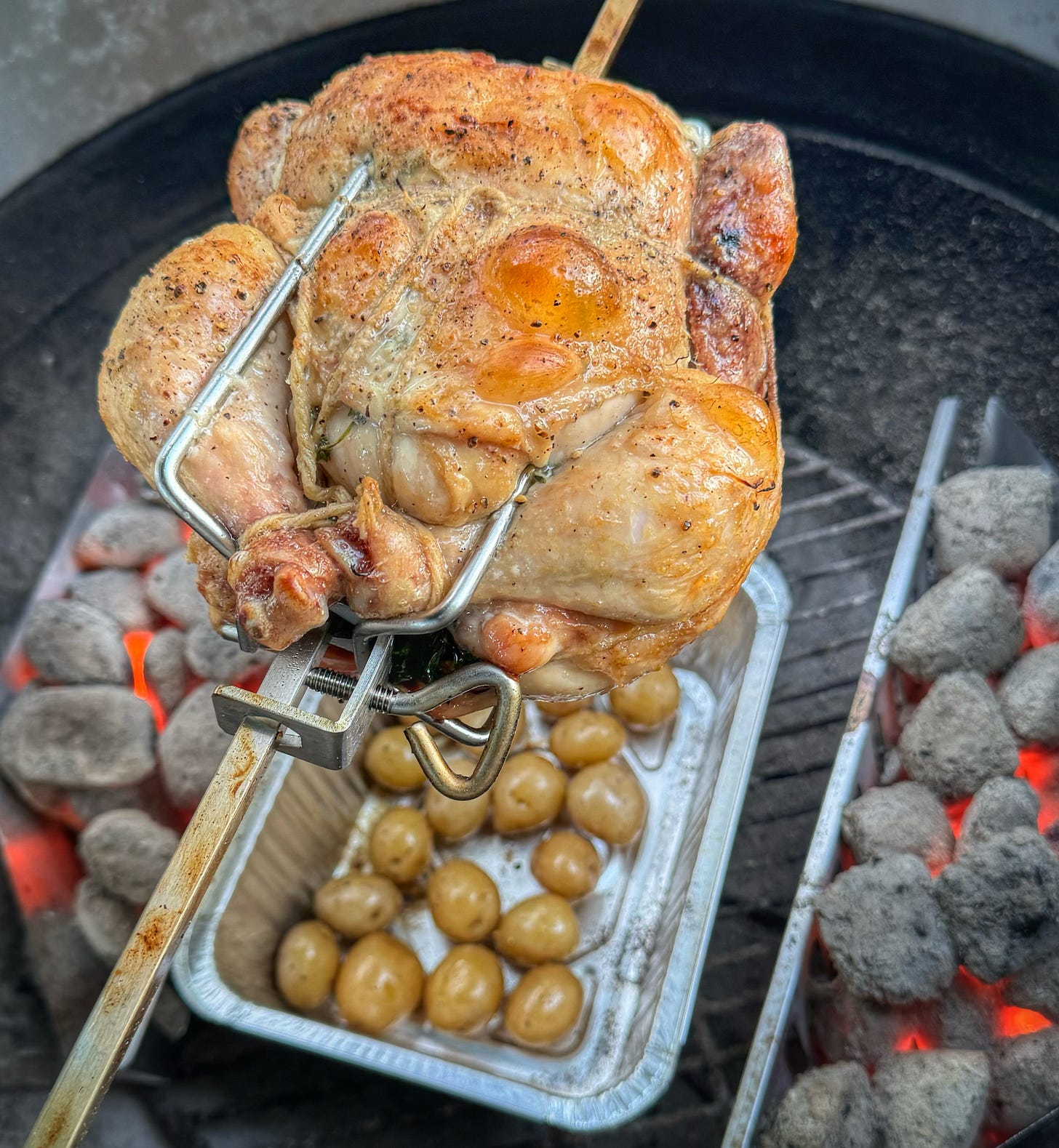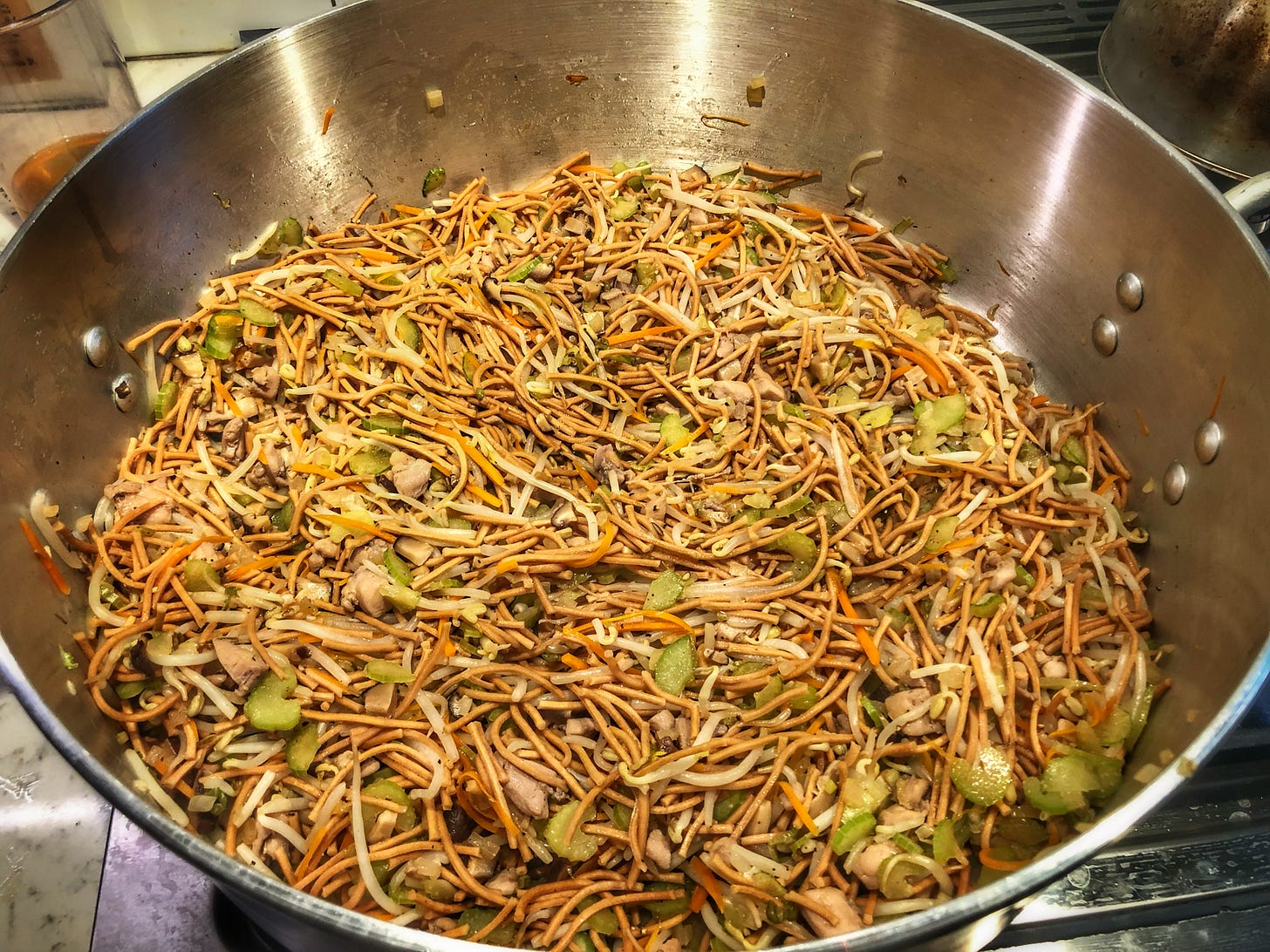50. A Plate Cleaner Looks at 50
A buffet of earlier issues
Once again it has been a while since I last published. I won’t lie to you, much like looking down the barrel of other 50ths can be daunting, so was trying to figure out what to write for the 50th issue of The Plate Cleaner. I have a list of other things I plan to write about, but none of them seemed right for the occasion. What made things even worse is that nothing seemed right for this occasion. Perhaps I’m just not good with milestones, particularly as they only seem to grow more precipitous and vertiginous as time passes.
None of this apprehension, of course, should take away from the gratitude I feel to all of you. Whether you are a OG reader or someone who signed up yesterday, I appreciate your being here. Again, it’s kind of unbelievable that even one person would want to read anything I write, so whatever boost to my ego I might feel is offset by a countervailing increase in my sense of imposter syndrome. Nature seeks balance, I guess.
But back to my search for what to write about in this 50th issue. Eventually, I realized that I should embrace my Gen X heritage, and with it the form that so many sitcom writers from the formative years of our TV watching—the ’70s and ’80s—relied upon when they had nothing left in the tank. Whether it was because the writers needed a few more episodes to get to syndication, or there was no budget left to shoot additional scenes, there was always one tried and true solution: put together a clip show.
There is a long tradition of repackaging previously released material that goes back further than Happy Days, of course. Though I might have been inspired originally by 1970s clip shows, I’m putting this issue together more in the spirit of movie serials from the 1930s, which included a recap so that to audiences who might have missed the previous episode of Mandrake the Magician or Flash Gordon could be brought up to speed. Many of you are new enough that you may have missed some of my favourite issues. Or, if you’ve been here since the beginning, this is a chance to say, “Wow, his writing has gotten so much better/worse.” (I leave it up to you to decide.)
With 49 issues to choose from, trimming the list was harder than I anticipated. Mostly because 49 is a large number and required a lot of re-reading,1 not because it was a 49-way Sophie’s Choice. There were a few on the bubble, but they ultimately fell outside my top five issues.2
And now for my top five issues of Plate Cleaner:
#5 — On the Pulse Side
My second issue ever! It’s a combination of early pandemic thrift and the cookalong posts I used to do on Instagram3 before I started The Plate Cleaner. The recipe for ragout of Beluga lentils is still one I make regularly during the cooler months.
Judging from the feedback I received, it seems like I sold a few bags of lentils, as well as a bunch of 1/8 sheet pans, which I lauded for being incredibly versatile. It’s also the first instance of my railing against recipes calling for “one medium carrot” without defining in absolute terms like grams or cups what a medium carrot actually is, something I would develop into a full issue of its own a couple of years later.
#4 —Rehearsal Dinner
Another recipe that is still in my repertoire today. In cooler months I roast chicken indoors in the oven. As soon as it gets too hot for that, I roast chicken outside on the grill or, this year, on my new rotisserie attachment.
However you decide to roast yours, this recipe lays out the principles that will elevate your roast chicken to another level of greatness, even approaching perfection. Yes, there are a lot of little steps and the process spans several days, but none of the steps—and I feel like this is maybe becoming my trademark—are difficult in and of themselves. Individually, they are quite easy; there are just a lot of them.4
#3 (Tie) — Lost in the Fog and Heat-Adjacent Cooking
Ah yes, the mental errors. Whether it’s filling my salt dish with sugar or trying to cook a chicken with the oven off, I make my share of mistakes in the kitchen.
Everyone does. I’ve always felt it was important to share my mistakes as well as my successes. You’ll get no pressure from me to be perfect. It’s a theme I also explore in Govern Yourself Accordingly, an issue about not living in fear that Gordon Ramsay is going to scream at you for messing up. The best way to cook is the way you cook.5
#2 — Tales from the Cookbook Section
It took a while to figure out what I wanted to say about thrifting cookbooks, but I’m really happy with the way this issue turned out.
Having spent another eight months rummaging through thrift store shelves since then, I might tweak the list of the books you’re most likely to find on shelves, but I stand by my central thesis: thrift store cookbooks tell us about what kind of cooks we aspire to be and what kind of cooks we actually are. In Everybody Lies, Seth Stephens-Davidowitz shows how much more revealing Google search data can be than surveys because (wink to the camera) everybody lies on surveys, but everyone asks Google what they really want to know. In much the same way, the Value Village bookshelves don’t lie.
#1 — The Mein Event
This will probably never not be my favourite. Partly because it’s about my family but mostly because it’s about Japanese-Canadian chow mein.
Beyond the writing of it, it’s the fond memory attached to that moment in time—New Year’s Day, 2021. Beth and I packed up the car with containers of chow mein and made the rounds in Toronto, Burlington, and Waterloo, making sure that, from a safe distance, everyone who was missing out on our traditional New Year’s Day open house at least got a few of their favourite bites. Last week, digging through the pantry, I found a few stray packages of Marufumi mein noodles, so I may have to whip up a batch soon.
If you have a favourite issue of The Plate Cleaner, I’d love to hear about it. Let me know in the comments below or by replying to this email (if you’re a subscriber.)
What I’m consuming…
River Cottage Handbooks I’ve been a longtime fan of Hugh Fearnley-Whittingstall’s River Cottage. It started out as a TV series and a small cottage in Dorset, where HFW (please don’t make me type that out every time) tried to become self-sufficient by growing his own produce and raising his own animals. It has since become an enterprise/juggernaut, with multiple shows, an event space, a restaurant and inn, a cooking school, and a growing library of terrific books.6 I’ve recently gotten my hands on three volumes of the 18-edition Handbook series: Preserves, Bread, and Edible Seashore.

Three down, fifteen more to go. Will I collect this whole set before I finish my James McNair collection? Of the three, Edible Seashore is definitely the least useful, as I live nowhere near the British seashore. Having been on a multi-year pizza adventure,7 I started in on Bread first. I’ve read a lot of bread books lately, but I am enjoying the easy-going nature of both Daniel Stevens’ writing and his approach to baking. If I can’t be in the kitchen kneading (or, foreshadowing, stretching and folding) dough, this is the next best thing.
Martin Philip’s bread videos for King Arthur Baking Speaking of bread, I think one of the reasons I’ve been having success with pizza is because I’ve watched a lot of Martin Philip’s videos lately. The one below, for high-hydration8 Pan De Cristal, in particular is a great lesson in how to handle a dough that is so wet it starts out more like batter than dough. It also teaches you how to use the stretch-and-fold method to develop gluten and structure instead of conventional kneading, which is great for people with less strength in their hands or for whom kneading is painful. It was a key to helping me figure out how to get my Roman-style pizza dough to a good place. Definitely give it a try. (There’s also a second video about shaping the same dough into baguette shapes to make great sandwiches.)
The New York Times says cabbage is cool. As I mentioned above, a full fourteen months before the Times wrote an article called, “The Coolest Menu Item at the Moment Is … Cabbage?” I wrote about its many uses. #influencer
What’s on the menu…
Kaitlyn’s Special Noodles from The Woks of Life I made this on Monday and it’s on the schedule again for next week.
A mix of ground pork (you could easily substitute ground chicken without noticing much difference), lo mein noodles,9 stir-fried greens, and a one-two punch of Sichuan peppercorns and Lao Gan Ma Black Bean Chili Sauce, it’s a fast and somewhat feisty meal in a single dish.
I have a duck in the freezer that will eventually find its way to the backyard and the rotisserie spit for some version of Rotisserie Duck with Drip Pan Potatoes. This week is calling for a lot of rain so I may have to wait a bit. In the meantime, I will continue to watch this video and drool.
At this point in the issue, time-consuming = hard.
Those issues covered things like stomping on a bag full of noodle dough, what to do with an entire 7.5-lb cabbage before it goes bad, and a recap of the resumption of an annual food crawl through Toronto’s suburbs.
Remember how before I wrote that “time-consuming = hard”? That really just applies to me. As far as you’re concerned, at least in my mind, time-consuming does not necessarily equal hard. Think of this as the cooking adjunct to Mel Brooks’ famous bit, where “Tragedy is when I cut my finger. Comedy is when you fall in an open sewer and die.”
Twenty-year-old me is rolling his eyes and making a barf gesture.
I’ve already got The River Cottage Cookbook, The River Cottage Meat Book, River Cottage Veg, and Hugh’s Three Good Things. That last one also gets a mention here, as the inspiration for a pasta dish that, unlike other recipes that lie to you about how long they take, can actually be made in the time it takes for the pasta to be ready.
Which finally seems to be paying off! In the last month I have made all three of the styles of pizza in my repertoire—NY-style, Roman-style, and Neapolitan—and they all went off without a hitch. Whatever problems I was having with tearing my dough while stretching it seems to have been fixed (although I am sure I have jinxed it now). It turns out that the best way to develop your skills is lots of practice. (If the next issue of The Plate Cleaner fails to come out in what you believe to be a reasonable amount of time, please feel free to quote this back to me.)
Hydration refers to the ratio of flour to water in a recipe. For whatever quantity of flour you are using, the water is expressed as a percentage of it. So if you have 1000g of flour and 600g of water, the hydration of your dough is 60%, which is typical for a Neapolitan pizza or many breads. Expressing recipes in what are called Baker’s Percentages make it very easy to scale recipes up or down.
Being Canadian, I wasn’t sure what lo mein noodles actually were, since they aren’t usually referred to by that name here. They are thicker and yellower than the wonton or chow mein noodles that are also available in Asian groceries. The ones I bought last week were called “Pre-cooked noodles.” The ones in my fridge right now are called “Pre-cooked miki noodles.”








